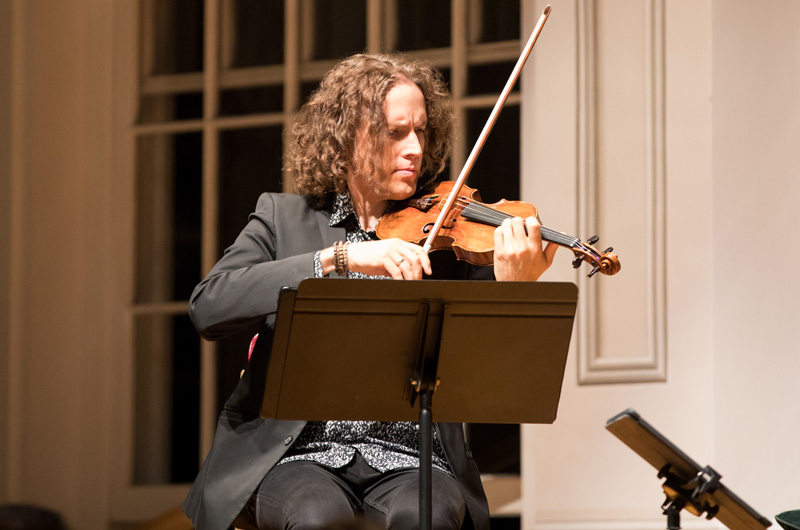At the end of the second movement of Cesar Franck’s Violin Sonata in A Major for violin and piano, something unusual happened. When the performers paused, the audience burst into applause and the musicians had to wait before continuing. While they waited, pianist Delores Stevens and guest violinist Tim Fain looked at each other and grinned broadly; it had been quite a passionate workout.
The concert on Monday was part of the Martha’s Vineyard Chamber Music Society summer series.
The first set of Virtuoso Strings included three compositions that explored the roots and branches of the Romantic movement in music. The evening began with Franz Liszt’s symphonic poem Orpheus (1853-54). Originally written for a small orchestra, Camille Saint-Saëns later transcribed it for a piano trio. This lush, dramatic piece sounds like a three-way conversation between the piano, the cello and the violin. In a sense its structure represents a principle of Romanticism: that the arts should speak to each another. Liszt’s tone poem is music inspired by a myth and several paintings. The cross-pollination has continued; it is also easy to hear the influence of Liszt on film score composers like Bernard Herrmann and Alfred Newman.
Luigi Boccherini’s Cello Sonata No. 6 in A Major (1768) — a duet between Ms. Stevens and guest cellist Jan Müller-Szeraws — is a Classical piece that includes elements of what would become Romanticism. This is particularly apparent in the second movement (allegro) where Müller-Szeraws athletically performs the passionate melody — if you removed his instrument his movements would have resembled those of a modern dancer.
Behind the cellist’s exuberant playing, Ms. Stevens’ accompaniment was a very orderly dance tune that harkened back to the Baroque period. Romantic composers would return counterpoint to art music, it having been downplayed during the Classical period. But while Baroque music was inspired by dance music, Boccherini’s sonata was very much made to sit and listen to. It is a fascinating nesting of folk and dance themes within the matrix of elegant musical mathematics.
In contrast, Franck’s sonata, which concluded the first set, was composed in 1886 as Romanticism gave way to the Modern movement. This was a duet between Fain — with shoulder-length curls and wearing a thrift-shop jacket, skinny jeans and a shirt patterned to look like a television jammed between channels — and Stevens, who was turned out in one of her trademark elegant gowns. The audience was treated to the sight of the violinist swaying and rocking as he played, impelled by the rhythm of the piece.
The piano is an equal partner in this duet and Ms. Stevens executed the tumbling notes with elan, playing with great animation. This is a famously difficult movement and lesser players than Ms. Stevens sometimes employ a third hand. All traces of dance music are absent in this sonata; this is a pure listening experience. The listener is taken on a journey during which much happens and even more is felt. Dissonance creeps into the composition in some of the piano chords, presaging the approaching advent of Modernism and jazz.
After the intermission, Ms. Stevens, Mr. Fain, and Mr. Müller-Szeraws presented a crowd pleaser, Johannes Brahms’s Piano Trio, Op. 8. Written around the same time as Liszt’s tone poem, the Brahms trio is an entirely different animal — in four movements where Liszt’s is one, and highly schematic where Liszt is organic. The second movement, scherzo: allegro molto, begins with each instrument repeating the same phrase in turn. Thereafter the strings are more or less in concert, while the piano plays the counterpoint. The final allegro movement includes arresting rhythmic figures from the cello, chunky low-register sounds that Mr. Müller-Szeraws clearly enjoyed making.
The “jazz notes” that lurked in Franck’s chords will come into full flower in the next chamber music society concert. On August 7 and 8 the Harlem String Quartet with pianist Aldo Lopez-Gavilan will present compositions by Dizzy Gillespie and Billy Strayhorn in a program that begins with the string quartet Serioso from that great Romantic, Ludwig van Beethoven.
For more information visit mvcms.org.








Comments
Comment policy »